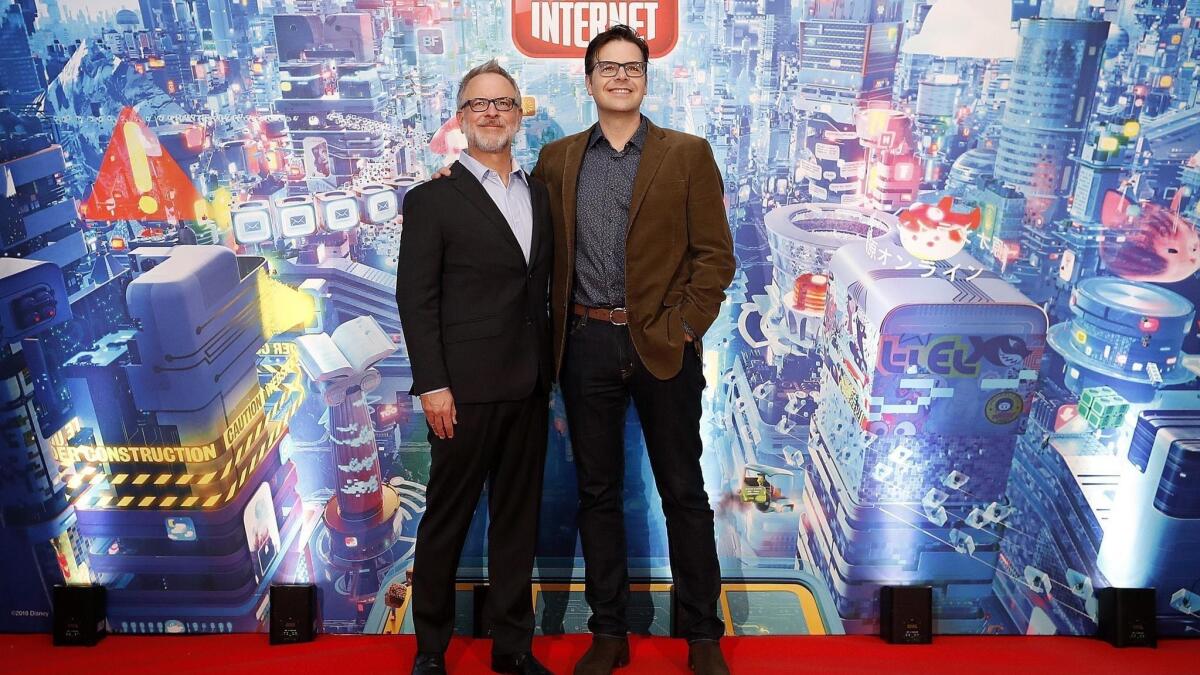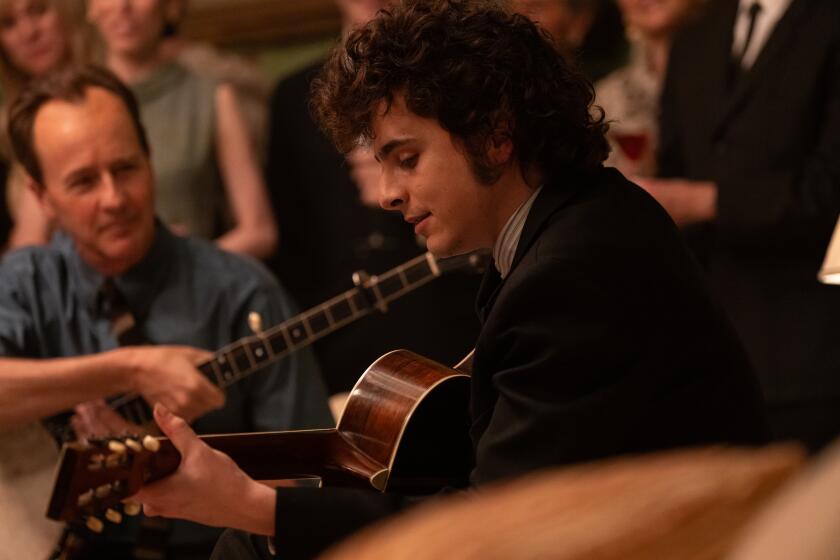With ‘Ralph Breaks the Internet,’ Walt Disney Animation Studios enters a new chapter in its history
- Share via
When Rich Moore and Phil Johnston first began developing the 2012 Disney animated feature “Wreck-It Ralph,” they had one overriding goal: to make a genuinely funny movie.
Not cute. Not chuckling quietly to yourself pleasant. Just flat-out funny.
Having come from outside the Disney fold — Moore had cut his teeth on “The Simpsons” and Johnston had scripted the R-rated indie comedy “Cedar Rapids” — the two were initially cautioned by some not to get their hopes up.
“I remember people saying, ‘It’s impossible — Disney animation is clever and amusing and sweet, but it’s not built to be funny,’ ” Moore said recently at the Walt Disney Animation Studios headquarters in Burbank. “But we came in here with the dream of proving that you could make a very, very funny Disney film.”
By every measure, Moore and Johnston — who, respectively, directed and co-wrote the film — succeeded. The story of an old-school video-game bad guy named Wreck-It Ralph (voiced by John C. Reilly) who sets off to prove he can be a true hero and befriends a feisty fellow arcade character named Vanellope von Schweetz (Sarah Silverman), “Wreck-It Ralph” earned strong reviews, an Oscar nomination for animated film and grossed $471 million worldwide.
Now, Moore and Johnston have co-directed a sequel, “Ralph Breaks the Internet,” which sends Ralph and Vanellope out of the comfortable confines of the arcade and into the dizzying wilds of cyberspace. The first feature-length theatrical sequel from Walt Disney Animation Studios since 2000’s “Fantasia 2000,” the film hits theaters Nov. 21 and is expected to easily wreck the box office competition.
When the first “Ralph” opened, Disney’s animation division was still in the process of pulling itself out of a protracted slump. In the early 2000s, even as its corporate sibling Pixar cranked out smash after smash, hundreds of jobs had been slashed at Walt Disney Animation Studios in wake of such duds as “Treasure Planet” and “Home on the Range.” Some feared that what was once the heart of the company’s empire could end up being shuttered.
But under Pixar heads John Lasseter and Ed Catmull, who assumed leadership of Disney animation in 2006, the division began to find its mojo again. Shifting from an executive-driven model to a filmmaker-driven one, Walt Disney Animation Studios kicked off on an impressive string of hits including “Tangled,” “Wreck-It Ralph,” “Frozen,” “Big Hero 6,” “Zootopia” and “Moana.”
“As we were starting on ‘Wreck-It Ralph,’ it seemed like there was a sense of confidence that was starting to bubble up that had been absent for a while,” Johnston said. “To me, if you’re not confident, you’re not going to take risks — and if you’re not taking risks, you’re not going to make anything particularly interesting. We were just encouraged to be as weird as we felt like and see how far we could push the story and the medium.”

Now, as “Ralph Breaks the Internet” heads toward theaters, Disney animation finds itself in another period of transition. Until recently the most powerful figure in the animation world, Lasseter exited the company late last year in wake of allegations of sexual misconduct, and last month Catmull announced plans to step down at the end of this year, staying on as an advisor through July 2019.
This summer, Jennifer Lee, the director of “Frozen,” was named chief creative officer at Walt Disney Animation Studios. All eyes will be on the division to see whether it can continue its winning streak under its new regime, with “Ralph Breaks the Internet” providing the first test.
Moore and Johnston followed up “Wreck-It Ralph” with 2016’s “Zootopia,” which explored themes of tolerance and diversity, grossed more than $1 billion worldwide and won the Oscar for animated feature. Emboldened by that success, the two sought to invest “Ralph Breaks the Internet” with deeper messages about insecurity, co-dependence and the sometimes toxic culture of the internet — wrapped, of course, in the shiny package of a fun adventure.
“Kids are way smarter than we ever give them credit for, and our job isn’t to sit there and preach,” said Johnston. “It’s to tell an entertaining story, where hopefully the characters go through some deep things that are relatable and universal.”
And just as they did in the original, the filmmakers were intent on delivering big laughs that test the limits of the Disney brand.
In what is certain to be among the most crowd-pleasing sequences in the film, Vanellope wanders into the fan website Oh My Disney and meets all the Disney princess. When they first pitched the idea for the scene, Moore and Johnston weren’t sure how the idea of tweaking beloved characters like Snow White, Cinderella, Belle, Mulan and Ariel would go over with the studio’s top brass.
“We are satirizing sort of the crown jewel — those princesses are kind of the reason for being of the studio to some extent,” said Johnston. “But they loved it. They were like, ‘Keep going, go further.’ ”
Under Lasseter and Catmull, Walt Disney Animation Studios had created a peer-driven story trust, in which the studios’ writers and directors come together to screen and comment on one another’s work. The process can sometimes be tough on filmmakers’ egos, but Moore and Johnston say it unquestionably produces stronger films.
“From when we started working on ‘Ralph Breaks the Internet’ to now, Rich and I have received over 30,000 pages of notes,” Johnston said. “We were in notes sessions constantly with everyone saying, ‘What about this? Why did you do that? Did you ever think of this?’ But listening to feedback is helpful, and rewriting and remaking the movie is how it becomes great. That is the beauty of this collective.”
“Ralph” producer Clark Spencer, who has worked in Disney animation for 25 years, fully expects Lee — who started her own Disney career as a cowriter on “Wreck-It Ralph” — to continue to foster that collaborative culture.
“We’re in a transition period, and that inherently means we will continue to evolve and change as a studio, but in terms of the tenets of having a story trust, that’s not going to change,” Spencer said. “Jennifer sees that value, and she knows how fortunate we are to have it. And what she’ll bring to the table in spades is that, as a writer, there’s nobody better in terms of understanding the best way to tell a story.”
After “Ralph Breaks the Internet,” Disney animation will next serve up the sequel to the 2013 juggernaut “Frozen,” which is due next November. Lee is returning to direct the follow-up, and, given the gargantuan success of the original film — which grossed more than $1.2 billion worldwide — expectations couldn’t be any higher.
With its recent string of successes, morale has clearly been running high at the Walt Disney Animation Studios headquarters, which recently underwent an extensive two-year renovation. Perhaps that’s why, as critical a figure as Lasseter had been within the division, when he announced he was stepping down midway through production on “Ralph Breaks the Internet,” Moore and Johnston took the news in stride.
“There was never a moment of, ‘Good God, what are we going to do?’ ” said Moore. “It was more like, ‘OK, we’re a film studio. We make animated films here. We know how to do this. We need to keep moving forward.’
“Disney animation has never been just about one person. It’s about the group and it’s about the dream. And over the past year, never has that been more real.”
Twitter: @joshrottenberg
More to Read
Only good movies
Get the Indie Focus newsletter, Mark Olsen's weekly guide to the world of cinema.
You may occasionally receive promotional content from the Los Angeles Times.











